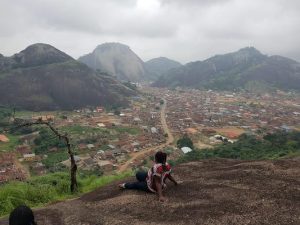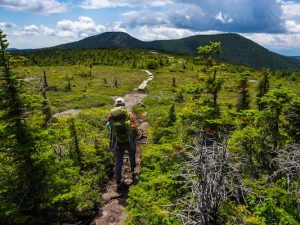
Between spotting the Big Five on safari and relaxing on the white-sand beaches, it’s easy to forget that Kenya has some superb hikes.
This country has spectacular scenery for those exploring on two feet: you could be trekking through lush emerald-green forests or hiking along a crater ridge with views over a shimmering lake, spotting colobus monkeys scampering across the path, and taking in vast valleys, baobabs and acacia trees as the sun sets. Kenya’s trails aren’t just for hikers: they also attract birders, cyclists and runners.
Forge new connections on your next adventure with the latest advice from our weekly newsletter.
From the country’s highest peak of Mt Kenya to the scenic, flat paths through Karura Forest on Nairobi’s outskirts, Kenya has a variety of hikes, paths and trails to suit every level. None of the trails are so crowded that it’s an issue, and many offer genuine tranquility.
Community tourism is an integral part of Kenya’s travel landscape, and local guides offer insights into their culture, traditions and relationship with the land, which is as much a part of exploring the country’s diverse and fantastic trails as the walking itself. Guides are always available at national parks, and you can also ask your accommodations for recommendations.
 Mt Kenya National Park is the ultimate hiking destination © Martin Mwaura / Getty Images
Mt Kenya National Park is the ultimate hiking destination © Martin Mwaura / Getty Images
Mt Kenya
Best bucket list hike
70km (43 miles) round trip, 5–7 days, challenging
Mt Kenya’s X factor isn’t just that it’s Kenya’s highest peak (and the second-highest in Africa) – the scenery of Mt Kenya National Park is astonishing. Ridges and valleys fan out from the summit as you hike on Afro-Alpine moorland, home to flora such as giant lobelia trees and groundsel, and take in the views of the massif from the MacKinder Valley.
It’s a challenging but doable hike with the right support and guide. Point Lenana at 4985m (16,355ft) is the main trekking peak (the two highest peaks, Batian and Nelion, are more technical and not climbed as frequently). The three main routes to Point Lenana – Naro Moru to the west, Sirimon on the northwest and Chogoria (the driest route and the most scenic ascent) on the southeast – start in Mt Kenya National Park.
The park is well-staffed with rangers and guides, and huts and campgrounds are set up on the trails. A guide is recommended, and you can book one at the entrance/visitor center or in advance, through your accommodations or word of mouth. A reasonable degree of fitness helps, and it’s wise to allow time for altitude and acclimatization.
Mt Kenya–Met Station
Best one-day bucket list hike
20km (12.5 miles) round trip, 7 hours, moderate
Instead of spending days trekking up Mt Kenya, you can hike to the Met Station campsite at 3050m (10,000ft) altitude. It’s a great hike through forest and bamboo habitat, starting from the Naro Moru gate, with a steeper section kicking in about two hours into the trek at Percival’s Bridge. Look out for buffalo, elephants and colobus monkeys.
If you’re a fast walker or time is on your side, you can keep going for another hour or so into the Alpine habitat beyond the camp, the first campsite on this Naro Moru trail. It’s worth it for the views over the Alpine zone, across the savanna to the snow-capped peaks ahead, while classic flora such as lobelia and giant heather fills the foreground with color.
 Walk through the narrow gullies of Hell’s Gate National Park © Anita SKV / Shutterstock
Walk through the narrow gullies of Hell’s Gate National Park © Anita SKV / Shutterstock
Hell’s Gate National Park
Best hike for rock climbers
24km (15 miles) round trip, 7 hours, easy
Don’t be fooled by the name: Hell’s Gate National Park is a place of joy. After two volcanoes erupted, the volcanic rock formed a series of gullies, ridges and remarkable formations, giving one of Kenya’s smaller national parks one of the most striking landscapes around.
The cliff face formed by the Rift Valley is popular with both beginner and experienced rock climbers, and you can go abseiling too. The 23m-high (75ft) rock formation known as Fischer’s Tower is the rock climber’s dream. It’s classic Rift Valley scenery, formed after molten volcanic lava shot up through a crack in the earth. It’s one of several rock formations for rock climbing in the park. You can also book expeditions through Climb BlueSky, a Nairobi-based rock climbing gym.
The trail along Ol Njorowa Gorge is one of the best ways to explore the landscape of Hell’s Gate, and along the way, you’ll see hot water springs that feed into a stream at the floor of the gorge.
Mt Elgon
Best hike for Kenya–Uganda views
56km (38 miles) round trip, 4 days, moderate
An extinct volcano on the border of Kenya and Uganda, one of Mt Elgon’s best treks – the trail up to Koitoboss Peak at 4187m (13,700ft) – falls on the Kenya side with views over Uganda and Kenya. Mt Elgon National Park is renowned for its mist and drizzle, but you’ll always be rewarded with scenes of rolling hills, caves created by ancient lava tubes, two gorges and hot spring lakes (mostly on the Uganda side). Best of all, it’s relatively uncrowded and tranquil.
Park fees include a guide and ranger (you can’t hike without a guide). Contact Kenya Wildlife Service before you arrive to arrange a local guide or book through a private travel company. The trail to Koitoboss Peak begins at the Rongai gate and steadily rises into the misty hills. If you’re lucky, you might spot the genet cat as you go.
 It’s a steep hike to the crater at Mt Longonot © Elena Ska / Shutterstock
It’s a steep hike to the crater at Mt Longonot © Elena Ska / Shutterstock
Mt Longonot
Best day hike from Nairobi
10km (6 miles) round trip, 7 hours, challenging
A now-dormant volcano that last erupted in the 1800s, Mt Longonot is a scenic ascent through dense mountain forest before reaching the summit at 2276m (7500ft). In the Great Rift Valley southeast of Lake Naivasha and just an hour from Nairobi, Mt Longonot is one of Kenya’s best trekking trails.
It’s a steep 3.2km (2-mile) trail up to the rim of the crater – Longonot takes its name from the Maasai word for “steep ridges” – and doable in a day if you’re in good shape. Add on a couple of hours if you want to explore and walk around the crater at the summit. The 7.2km (4.5-mile) loop is well worth it for the panoramic view over the Rift Valley and Lake Naivasha, and you’ll often see birds of prey swooping into the scene.
Menengai Crater
Best hike for expansive views
10km (6 miles) round trip, 6 hours, challenging
An entire natural world has formed inside the caldera depression that’s been created at the Menengai Crater, the world’s largest surviving crater. It makes for a unique hike as you explore this ecosystem of wildflowers, grasslands and forest, and spot the geothermal plants that thrive in this landscape of geysers, hot springs and mud pots.
A ring of walls and hills circle the crater, around 600m (1968ft) from the base, while the summit lies at 2288m (7506ft). The views from the crater ridge over Lake Bogoria, Lake Nakuru and the Northern Rift Valley are wonderful as the water glimmers in the distance. From the viewpoint, you can take a steep hike down to the crater floor or head into the lush forest for sightings of dik-dik (small antelope), vervet monkeys, reedbuck and forest birds.
Masai Mara National Reserve
Best hike for wildlife
Variable distance, 2 hours to full day, easy to moderate
While walking safaris aren’t hikes in the traditional sense, they offer a new way to experience the terrain of the Masai Mara versus the classic 4WD experience. Armed rangers ensure safety, but being on foot allows you to see animals such as zebras, antelopes and giraffes in a more intimate way.
Many of these walks are guided by indigenous Maasai, traditional pastoral herders who know their land well. Many conservancies are on private Maasai-owned land that has been earmarked for conservation, so lodges often have strong ties to local communities, and you can request a local guide. Tell the guide what types of wildlife and landscapes you want to see and learn about Maasai customs such as wilderness survival.
Karura Forest
Best hike for families
5–15km (3–9 miles) round trip, 1–3 hours, easy
With waterfalls, a lake, Mau Mau fighter hideout caves, a forest cafe with animal sculptures and a small children’s playground, Karura Forest off Limuru Road is a much-loved oasis just on the outskirts of the city. The forest has more than 50km (30 miles) of hiking trails, which are mostly flat and perfect for families.
The 9km (5.5-mile) trail takes in some of the key attractions, such as sections home to Sykes’ monkeys, Karura Waterfall and Lily Lake. Also in Karura forest are the Mau Mau caves, which housed fighters and their supplies during Kenya’s fight for independence from Britain between 1952 and 1960. Finish your visit with a drink or lunch at The River Cafe on its spacious terrace overlooking the forest where wildlife sightings over a shake and panini are not uncommon.
Loop trail, Nairobi Arboretum
Best accessible hike
2.5km (1.5 miles), 1 hour, easy
Nairobi Arboretum is just 3km (1.8 miles) from Nairobi’s city center, and short, flat paths make it an ideal spot for an accessible walk. Inside the 74-acre arboretum are more than 350 exotic and indigenous trees and more than 100 bird species. You’re pretty much guaranteed to see Vervet and Sykes’ monkeys. For those with accessibility needs, the walkways are recently paved, the route has plenty of seating and the facilities, including public toilets, have been cleaned up.



